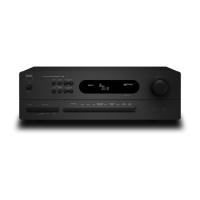•5 x 50W Simultaneous Minimum Continuous Power
•105W, 145W, 165W IHF Dynamic Power into 8, 4
•Dolby Digital, DTS, ProLogic II, EARS and
•5 A/V Custom Presets store unique speaker level and
•Direct access speaker level adjustment for surround,
•6 A/V Inputs, 3 with S-Video, 2 Full Tape Loops
• Component Video, 2 Inputs and 1 Output, HDTV
•2 Audio Inputs, 1 Tape Output
•6 Digital Inputs, 4 Coaxial, 2 TOS Link
•5.1 Analogue Input (for DVD-Audio)
•Speaker A + B switching (Speakers B stereo only)
•2 x IR Outputs, IR Input
•2 x 12V Trigger Outputs, 12V Trigger Input
•Preamp Outputs for all 5.1 channels (2 Subwoofers)
•Ampli er Input for 3 ampli er channels
•RDS FM/AM Tuner with 30 direct access presets
•HTR-2 - 8 Device Illuminated Learning Remote with
The NAD T 743 is heir to many generations of award
winning NAD designs. This exceptional pedigree is
evident in both the look and the feel of the T 743, and
it is unmistakable the moment you listen. Based on the
highly successful T 742, the T 743 boasts improvements
in virtually every area of the receiver, for a cumulative
effect that is fully deserving of the new model number.
Starting with a revised heat management system that
reduces internal operating temperatures even under the
most severe operating conditions, the T 743 includes a
new volume control circuit and input switching circuit that
further reduces noise and distortion. In addition, we have
increased the number of digital inputs and added speaker
switching for a second pair of stereo speakers. Also new
are the On-Screen Display, HDTV Component Video
Switching, and an illuminated learning remote, the NAD
Today’s advanced surround sound receivers require
quality in both the digital decoding stages and the
analogue amplifying stages for the best overall
performance. The T 743 is an excellent example of the
NAD Design Team’s expertise in both areas.
Using the latest high speed DSP technology, NAD
was able to include the newest surround formats from
Dolby and DTS, as well as including NAD’s own highly
regarded music surround mode, the EARS (Enhanced
Ambient Recovery Circuit) circuit. Unlike, the typical
arti cially enhanced DSP modes like “Club”, “Stadium”,
and “Church”, EARS uses DSP technology to extract the
natural ambience to create surround sound from any 2
channel source inducing a warm natural reverberant effect
without the arti cial “BOING”. Surround processing is
automatically detected via the digital inputs of the T 743,
and the “highest” or most advanced form of decoding is
switched in. Conversion of the decoded digital bitstream

